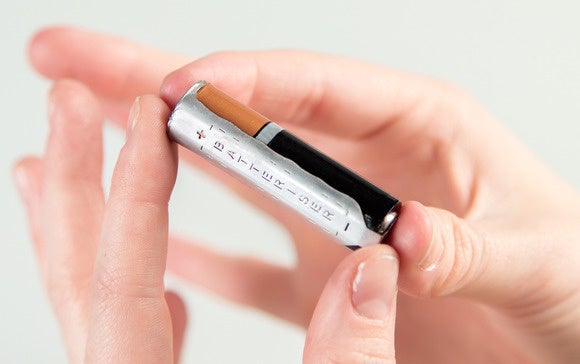
Posted on 06/03/2015 2:58:05 PM PDT by Enlightened1
“The Batteriser has boost circuitry that will boost the voltage from 0.6 volts to 1.5 volts and will maintain voltage at 1.5—which is a brand new battery,” Roohparvar says. “There’s actually no IP [intellectual property] in the boost circuitry. Our technology is really a miniaturization technique that allows us to build the sleeve. We have some IP in some of the IC circuits that are in there, but the key is we’ve been able to miniaturize the boost circuit to a point that no one else has been able to achieve. “
To prove that he’s not peddling snake oil, Roohparvar gave me a demonstration of Batteriser’s effectiveness.
First he ran tests on two “dead” AA batteries with a power meter. The batteries read 1.3 volts each. He then put the batteries inside a Bluetooth keyboard and connected the keyboard to a Mac. An onscreen display reported the batteries were toast. Such is the heartbreak of old-school battery tech. It’s been this way since 1947.
Next he slipped the batteries inside two Batteriser sleeves. He ran the metering test again. The same ostensibly dead batteries read 1.5 volts. He then slipped the batteries—now ensconced in Batteriser jackets—into the keyboard. Voila: The Mac reported the battery level at 100 percent.
Shocking? It shouldn’t be. Again, the basic concepts behind the voltage boost have been employed for years. Batteroo has simply scaled down the requisite hardware to a practical formfactor.
(Excerpt) Read more at pcworld.com ...

Not sure I’d leave it operating unattended.
I want the watt hour data over time.
If you rig it to run the circuits through your vacuum cleaner you get another 800 percent plus the girls will be amazed.
They jack up the voltage. Which I’m guessing that’s what the keyboard/computer use to report “charge”. If there is no current draw then it seems fine. Put a load on it and it will go down just the same. TANSYAAFL.
This WILL work, but only for circuits with extremely low drain and batteries with very, very low self-discharge rates (not NiMH batteries, for example, which have pretty high self-discharge).
Basically, let’s suppose that a Bluetooth keyboard (on average) draws 1mw at 3.0 volts and won’t work below 2.6.
When an ordinary battery crosses the 1.3v/cell threshold, it might still hold a small, but significant amount of energy that you wind up throwing away.
What they’ve done that is fairly novel, is to make a tiny, very efficient, very, very low voltage to very low voltage DC-DC boost converter. I wonder how low on voltage/current they can go to get 1.5 volts, and at what efficiency.
“They jack up the voltage. Which I’m guessing that’s what the keyboard/computer use to report “charge”. If there is no current draw then it seems fine. Put a load on it and it will go down just the same. TANSYAAFL.”
True, but in many circuits, that load might be measured in microamps. What might be a problem would be, for example, a temporary need for extra power (like Bluetooth transmission when most of the time it receives). A capacitor will help but it can’t perform a miracle.
It’s snake oil. I was hoping the sleeve would allow one to recharge conventional batteries. THAT would be good.
 Gadget HOF
Gadget HOF

I didn't know it was a fraud until the claim included converting 1.2 volt rechargeable cells to 1.5 volt cells.
This WILL work, but only for circuits with extremely low drain and batteries with very, very low self-discharge rates (not NiMH batteries, for example, which have pretty high self-discharge).
...
The better NIMH batteries are now low self-discharge, and NIMH batteries have a flat discharge rate, so this device wouldn’t improve them. The same goes for lithium batteries. So what this device may do is make alkalines discharge more like NIMH and lithium batteries.
Some LED flashlights have had similar boost circuitry in them for years.
.
“Dead” batteries don’t read 1.3 volts!
This has to be a scam. When a battery is depleted it isn’t going to be reincarnated.
“Dead” batteries don’t read 1.3 volts!
This has to be a scam. When a battery is depleted it isn’t going to be reincarnated.
_________________________________________________________
So we can assume you didn’t read this part of the article. Or maybe didn’t read the article at all?
“The battery’s chemical cocktail is still loaded with juice, but the circuitry in many gadgets (especially more sophisticated ones, like Bluetooth keyboards and bathroom scales) considers the battery dead.”
I didn’t know it was a fraud until the claim included converting 1.2 volt rechargeable cells to 1.5 volt cells.
___________________________________________________________
Why would you think this makes it a fraud? I can easily build you a circuit that can do that with no problem.
It’s just a form of a voltage doubler circuit that’s been around for years. There are even IC’s for it.
The big deal (and it is a pretty big deal) here is that it’s been micro-miniaturized to fit over a battery.
I might try it in a AA maglight. Never in any electronic equipment that I value.
Joule thief or battery thief. Old technology but they just figured out how to make it small enough to be practical on an existing device.
What these do is just suck most of the remaining energy out of the battery that you would normally throw away.
http://en.wikipedia.org/wiki/Joule_thief
Likely an oscillator & multi-tap transformer circuit. The concept is used for single battery LED flashlights, high voltage generators used to charge capacitors for EMP simulators. and battery operated tube radios.
The circuit design is not what caused me to be skeptical. I hadn’t considered that the miniaturization technology required was available. In light of your confidence that it is available I withdrawn the fraud assertion.
Disclaimer: Opinions posted on Free Republic are those of the individual posters and do not necessarily represent the opinion of Free Republic or its management. All materials posted herein are protected by copyright law and the exemption for fair use of copyrighted works.